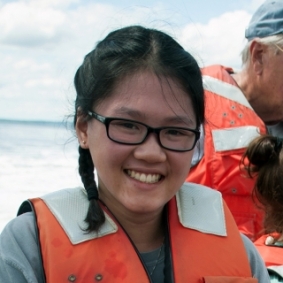Eight students will be presenting the summer work at the Ocean Sciences Meeting in March 2022!
Michelle Nguyen, Texas A&M University Galveston
Class Year:
2017Mentor:
Louis Plough, Ph.D.Project Title:
Morphological and metabolic changes observed in starved larvae of varying lineages of Eastern oyster Crassostrea virginica
Abstract:
Despite the increasing importance of aquaculture for oyster restoration, relatively little is known about the genetic implications of using aquaculture-grown oysters for restoration. Nutrient-rich environments, such as those seen in aquaculture, could significantly reduce larval resilience to starvation. To examine the potential for adaptation of larval feeding traits to the hatchery environment, we exposed larvae from both aquaculture and wild oyster populations to starvation and ad libitum (control) conditions and monitored growth, survivorship, and respiration. Both wild and aquaculture groups grew at a rate of 10.849 µm/day and 8.5977 µm/day, respectively. Starved larvae stopped growing during starvation at 114 microns, but resumed growing when food was reintroduced. Survival was reduced for starved aquaculture oysters (8-10 times less than wild larvae by day 25) after starvation, indicating that wild larvae were more tolerant of starvation. Preliminary respiration data, correlated with metabolism, indicated that starved wild larvae exhibited reduced respiratory responses, which eventually surpassed that of the fed treatments, possibly demonstrating compensatory performance. Overall, our findings suggest that wild larvae possess more tolerance to starvation than aquaculture oysters. Future work will examine the underlying physiology of starvation tolerance in wild oysters, and shed light on effects of hatchery propagation on shellfish restoration.
Location:
Horn Point LaboratoryPresentations:
Nguyen, M.*, K. McFarland, M. Hare, L. Plough. 2018. Physiological responses of wild and aquaculture Crassostrea virginica larvae to starvation conditions . Ocean Sciences Meeting, Portland, OR .




